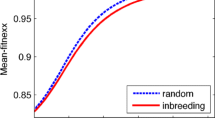Summary
An EM algorithm procedure is presented for the maximum-likelihood estimation of mating system parameters of mixed mating system models for both angiosperms and gymnosperms. One advantage of the procedure is the ability to accommodate any number of alleles in the mature population and pollen pool. Estimates of the outcrossing rate (\(\hat t\)) derived from the model are bounded strictly within the natural biological range (i.e., 0 ≦ \(\hat t\) ≦1).
Similar content being viewed by others
References
Allard RW, Kahler AL, Clegg MT (1975) Isozymes in plant population genetics. In: Market CL (ed) Isozymes IV. Academic Press, New York, pp 261–272
Brown AHD, Allard RW (1970) Estimation of the mating system in open-pollinated maize populations using isozyme polymorphisms. Genetics 66:133–145
Brown AHD, Matheson AC, Eldridge KG (1975) Estimation of the mating system in Eucalyptus obliqua L'Herit using allozyme polymorphisms. Aust J Bot 23:931–949
Brown AHD, Zohary D, Nevo E (1978) Outcrossing rates and heterozygosity in natural populations Hordeum spontaneum Koch. in Israel. Heredity 41:49–62
Ceppellini R, Siniscalco R, Smith CAB (1955) The estimation of gene frequencies in a random mating population. Ann Hum Genet 20:97–115
Clegg MT, Kahler AL, Allard RW (1978) Estimation of life cycle components of selection in an experimental plant population. Genetics 89:765–792
Dempster AP, Laird NM, Rubin DB (1977): Maximum-likelihood from incomplete data via the EM algorithm. J R Stat Soc Ser B 39:1–38
Fryxell PA (1957) Mode of reproduction in higher plants. Bot Rev 23:135–233
Green AG, Brown AHD, Oram RN (1980) Determination of outcrossing rate in a breeding population of Lupinus albus L. (white lupin). Z Pflanzenzücht 84:181–191
Jain SK (1979) Estimation of outcrossing rates: Some alternative procedures. Crop Sci 19:23–26
Morris RW, Speith PT (1978) Sampling strategies for using female gametophytes to estimate heterozygosity in conifers. Theor Appl Genet 51:217–222
Ritland K, Jain SK (1981) A model for the estimation of outcrossing rate and gene frequencies using n independent loci. Heredity 47:35–52
Shaw DV, Kahler AL, Allard RW (1981) A multilocus estimator of mating system parameters in plant populations. Proc Natl Acad Sci USA 78:1298–1302
Shaw DV, Allard RW (1982) Estimation of outcrossing rates in Douglas-fir using isozyme markers. Theor Appl Genet 62:113–120
Smith CAB (1957) Counting methods in genetical statistics. Ann Hum Genet 21:254–276
Wu C-H (1981) On the convergence of the EM algorithm. Tech Rep No 642. University of Wisconsin, Dept of Statistics
Yeh FC, Brune A, Cheliak WM, Chipman DC (1982) Mating system of Eucalyptus citriodora in a seed orchard. Can J For Res (submitted)
Author information
Authors and Affiliations
Additional information
Communicated by R.W.Allard
A program listing, documentation, and test data may be obtained from the senior author on request.
Rights and permissions
About this article
Cite this article
Cheliak, W.M., Morgan, K., Strobeck, C. et al. Estimation of mating system parameters in plant populations using the EM algorithm. Theoret. Appl. Genetics 65, 157–161 (1983). https://doi.org/10.1007/BF00264884
Received:
Issue Date:
DOI: https://doi.org/10.1007/BF00264884




